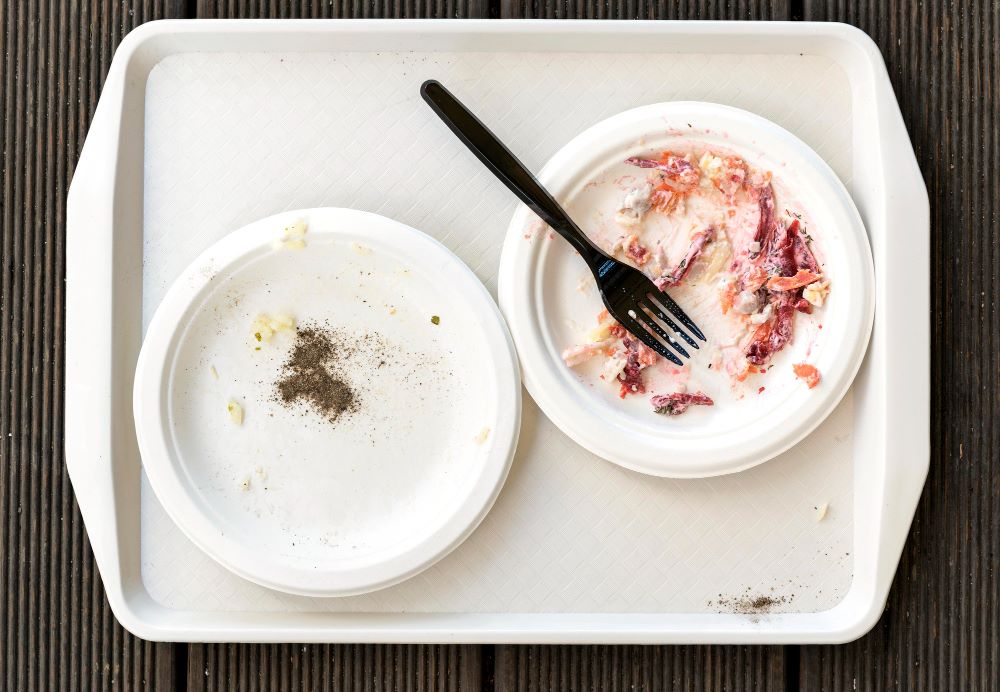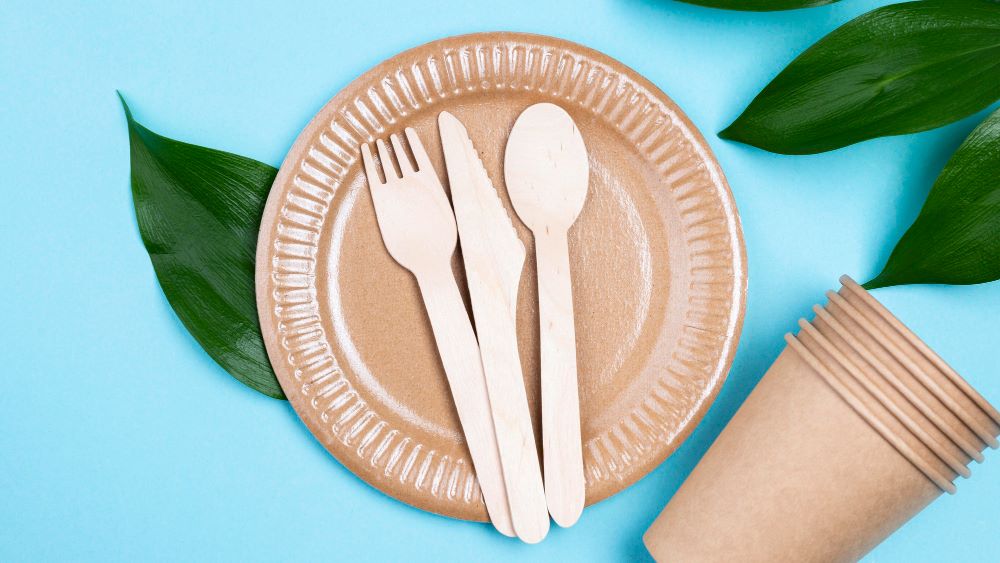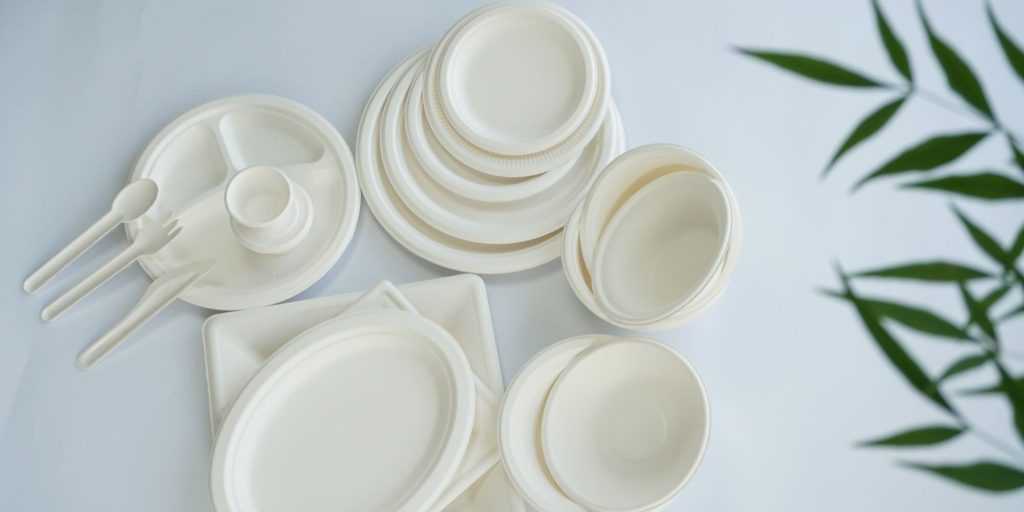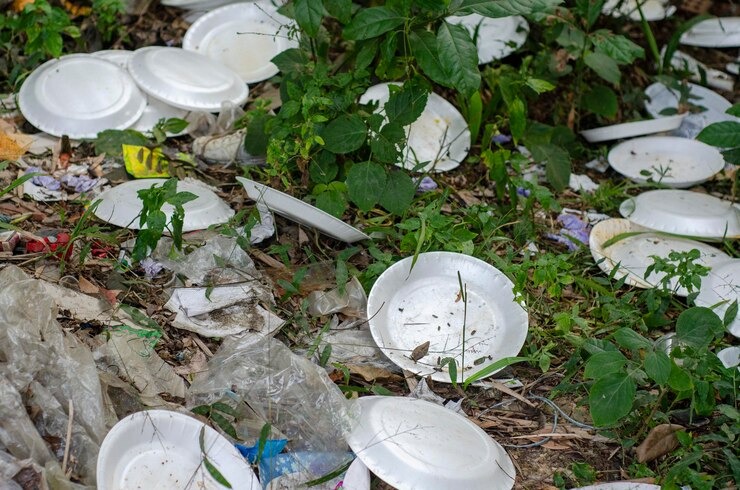Are paper plates recyclable? The short answer: sometimes. Whether your paper plate can be recycled depends on its material, coatings, and how it was used. Paper plates are recyclable if they are clean and free from food, oil or wax coatings.
In this article, we’ll break down the recycling challenges, explore better alternatives like bagasse tableware, and give you practical steps to make eco-friendly choices
Why Most Paper Plates Aren’t Recyclable
Paper plates are often rejected by recycling facilities for three main reasons:
1. Food Contamination

Food residue clings on paper plates even once wiped. Even small specks of oil, sauce, or crumbs can ruin the recycling run. Most recycling mills require clean paper to cut down costs and minimise issues.
Dirty plates, however, slow down sorting and can render entire loads worthless. It’s better to keep recyclables as clean as possible to avoid mucking up the system.
2. Plastic Coatings
Most paper plates are given a very thin coating of plastic for strength or to prevent leaks. This coating won’t come off so easily, which prevents the plate from biodegrading like normal paper.
If these coated plates enter recycling, they can jam machinery or contaminate recycled paper with plastic, lowering its quality. Some uncoated plates may be accepted, but they’re uncommon. The challenge of separating the plastic from the paper is one key issue.
3. Wax Linings
Certain plates use wax, rather than plastic, for a water barrier. Wax linings bring their own problems.
Recycling waxed paper involves additional steps, and most centres don’t have the appropriate set-up. Wax can contaminate recycled pulp, weakening new products. Waxed plates typically become trash unless composted in an industrial plant. Clear labelling would be useful to guide people.
4. Chemical Additives
Most have dyes, glues, or bleaches added. These make the plates look nice or stick together more effectively.
These kinds of chemicals can taint recycled material, leading to staining or health concerns. ‘Unbleached’, plain paper plates are better suited to recycling but most people don’t notice when buying.
5. Mixed Materials
A combination of paper and plastic, and sometimes foil or other layers, complicates recycling. Every single bit requires a different mechanism.
Mixed plates can contaminate entire recycling streams, as machines can’t sort them properly. Single-use, single-material does help, but not many understand the effect a mixed product has.
The Recycling Reality Check
Many assume all paper products, such as paper plates, go to recycling. Not always.
When paper plates are recycled, it’s not a piece of cake. First, workers sift through the plates, removing anything that can’t be recycled, such as plastic, food remains, or other waste. The plates are then mixed with water and mashed into a pulp. This pulp is put through a cleansing process to remove any remaining contaminants. Clean pulp is dried and formed into new products. Most paper can be recycled in this way five to seven times before the fibres become too weak.
It’s a fact that nearly half of all paper in the US is recycled, but food- or plastic-contaminated plates often don’t make the cut. With more than $120.5 billion worth of paper plates and cups produced in 2024, plenty still goes to waste. Every plate means more trees are chopped down, consuming valuable resources and energy.
What can be recycled also depends on where you live. Every region has its own regulations about what goes in the bin. Public awareness campaigns play a crucial role here—clear guidance helps prevent incorrect items from clogging up recycling systems. With better education, recycling rates could improve significantly.
This is why businesses and consumers are increasingly turning to alternative fibers like sugarcane bagasse, which avoids many of the recycling challenges while offering a truly compostable solution.
Identifying Recyclable Plates

Recyclable plates aren’t always easy to spot. The quickest way is to check the packaging for clear labels such as “recyclable,” “compostable,” or “biodegradable.” These symbols help you know the proper way to dispose of them. If no label is visible, look up the product online or check the brand’s website.
A simple rule of thumb: if a plate looks shiny or waxy, it likely has a plastic or wax coating. These coatings prevent recycling and usually belong in general waste unless your local regulations say otherwise.
Sugarcane Bagasse: A Better Alternative

Sugarcane bagasse is making waves internationally as a sustainable tableware solution. It’s a sturdy, functional, and greener alternative to disposable paper and plastic plates. Bagasse is derived from the pulp remaining once juice has been taken from sugarcane, so it’s using a by-product that would otherwise be discarded. This lessens dependence on trees and eliminates sugar production waste, positioning it prominently in zero-waste and circular economy movements.
What Is It?
Sugarcane bagasse is the cellulose plant residue resulting from extracting sugar juice from sugarcane. Rather than burning or dumping the waste, manufacturers turn it into plates, bowls and packaging. The bagasse breaks down by nature, so it won’t be hanging around in landfill for decades. Sugarcane grows back quickly, so there’s no deforestation needed for new material. This renders bagasse a sustainable and dependable source for everyday items.
Bagasse is much more than plates. It’s moulded into bowls, takeaway containers and trays that can deal with hot and cold foods. It’s heat resistant, strong, and can absorb liquids without crumbling. This makes it a better match for plenty of applications than regular paper plates, which usually require a wax or plastic coating.
Why Is It Better?
|
Feature |
Bagasse Plates |
Paper Plates |
Plastic Plates |
|---|---|---|---|
|
Source |
Byproduct (renewable) |
Wood pulp (deforestation) |
Petroleum (non-renewable) |
|
Compostable |
Yes |
Sometimes (if uncoated) |
No |
|
Breakdown Time |
60-90 days |
Months to years (coated) |
Hundreds of years |
|
Energy/Water Use |
Lower |
Higher |
High |
|
Heat Resistance |
High |
Medium |
Medium |
Bagasse plates decompose significantly faster than paper or plastic coated utensils. They decompose in 3 months when composted properly. When you choose bagasse products you are reducing deforestation, reducing waste and promoting sustainable practices at home, work or events.
How To Dispose?
- Put used bagasse plates into your home or industrial compost bins.
- If composting isn’t an option, bagasse can go in general waste bins.
- Ring your local composting sites to see if they accept bagasse?
- Scrape off the chunks of food (better yet, compost them) before putting your containers in the recycling bin.
Bagasse plates can decompose in compost in two to three months. Even in countries without composting, they remain less damaging than plastic or coated paper. Opting for bagasse prevents more plates from ending up in landfill and aligns with zero-waste ambitions.
How to Dispose of Paper Plates

Not all paper plates should be treated the same. How you dispose of them depends on whether they are coated, contaminated with food, or accepted by your local waste system.
- General Waste – Plates with grease, sauces, or heavy food stains usually belong in the trash. Recycling centres don’t want food-soiled paper, as it contaminates clean batches.
- Home Composting – Uncoated, clean paper plates can be torn up and added to a home compost bin, provided they are mixed with food scraps and garden waste for balance.
- Commercial Composting – For larger events or food businesses, commercial composting services can handle coated or heavily used plates in bulk, turning them into valuable compost instead of landfill waste.
Choosing certified compostable options—like bagasse plates—makes disposal far simpler, whether at home or through industrial composting facilities.
Practical Tips for Businesses
- Check local waste guidelines before labeling items as recyclable.
- Switch to compostable bagasse tableware to avoid customer confusion.
- Educate your buyers with clear disposal instructions.
Use eco-packaging as a brand advantage—today’s consumers are quick to support companies with real sustainable actions.
Conclusion
So, are paper plates recyclable? Sometimes, but the majority are not—especially once food or coatings are involved. That’s why many businesses are moving beyond paper plates and choosing bagasse packaging as a future-proof solution.
At InNature Pack, we supply durable, food-safe, and fully compostable bagasse plates, bowls, and clamshells for catering, foodservice, and wholesale distribution worldwide.
Contact us today to request samples or a tailored bulk quote—and make your next packaging choice truly sustainable.
Frequently Asked Questions
Are all paper plates recyclable?
No, the majority of paper plates aren’t recyclable. Most have plastic coatings or are soiled with food, rendering them unwanted by recycling plants.
Why can’t food-soiled paper plates be recycled?
Food and grease can contaminate the recycling. Recycling centres need clean paper, so plates with grease and food residue are not accepted.
How can I tell if a paper plate is recyclable?
Look for recycling symbols or information on the packaging, as many paper plates without a plastic layer and grease are more likely to be recyclable.
What is sugarcane bagasse, and is it a better option?
Sugarcane bagasse is what’s left over from the process of sugar production. Plates constructed from this are often compostable and more eco-friendly than ordinary paper plates.
Are compostable plates the same as recyclable plates?
Don’t recycle compostable plates! Instead they should be sent to commercial composters where they’ll achieve optimal results.
Can I compost paper plates at home?
Plain, uncoated paper plates can be composted at home, but only if they’re not greasy or oily. Coated or heavily soiled plates shouldn’t be composted at home.
What is the best way to dispose of used paper plates?
Provided it isn’t coated in plastic or contaminated with food, you can add it to the recycling bin or, if compostable, a commercial composting facility.

